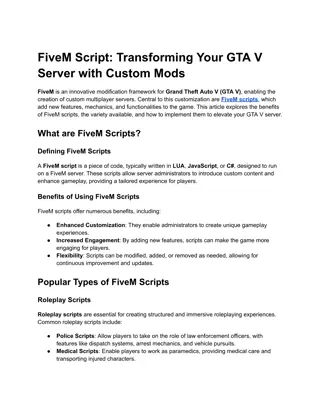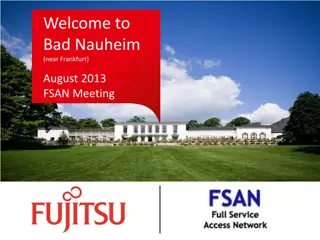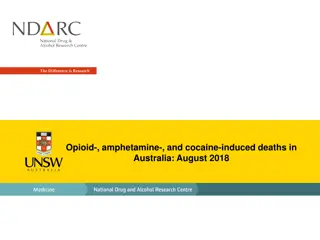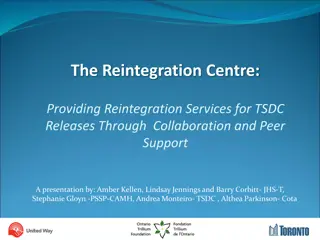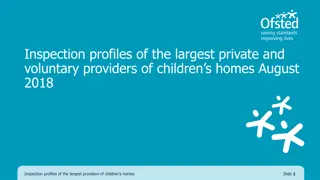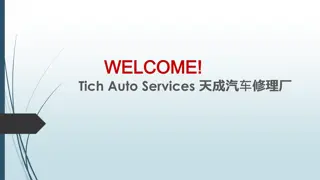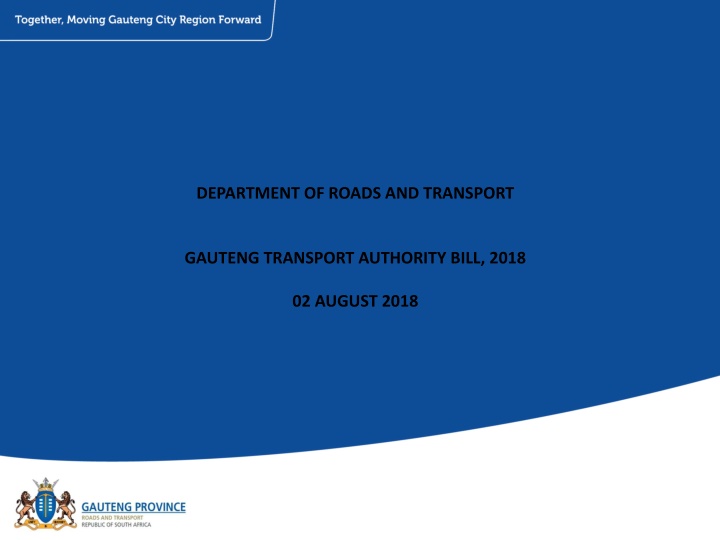
Gauteng Transport Authority Bill 2018: Transforming Transportation for Sustainable Growth
The Gauteng Transport Authority Bill, 2018 aims to establish a province-wide Transport Authority to address the challenges of high traffic volumes and population growth in Gauteng. The Bill outlines legislative imperatives, socio-economic implications, environmental impact, financial considerations, and communication strategies. By improving public transport accessibility and affordability, the Bill seeks to foster economic growth, reduce social disparities, and enhance transportation efficiency for future sustainability.
Download Presentation

Please find below an Image/Link to download the presentation.
The content on the website is provided AS IS for your information and personal use only. It may not be sold, licensed, or shared on other websites without obtaining consent from the author. If you encounter any issues during the download, it is possible that the publisher has removed the file from their server.
You are allowed to download the files provided on this website for personal or commercial use, subject to the condition that they are used lawfully. All files are the property of their respective owners.
The content on the website is provided AS IS for your information and personal use only. It may not be sold, licensed, or shared on other websites without obtaining consent from the author.
E N D
Presentation Transcript
DEPARTMENT OF ROADS AND TRANSPORT GAUTENG TRANSPORT AUTHORITY BILL, 2018 02 AUGUST 2018
Contents 1. 2. 3. 4. 5. 6. 7. 8. 9. 10. Background Situational Analysis Legislative imperatives Socio-economic implications Environmental Impact Financial Implications Communication Implications Constitutional and Legal Implications Clause-by-clause explanation Consultations with other bodies
Background The strategic plan of the Department provides its vision as : A modern integrated, efficient and sustainable transport and road infrastructure system in Gauteng . 25 year Integrated Transport Master Plan (ITMP 25) was presented to EXCO and adopted. The plan identifies key interventions needed to achieve the above vision. One of the key interventions is the Gauteng Transport Authority.
Situational Analysis Gauteng Province has high traffic volumes with a vehicle population of approximately 4,7 million which is expected to grow to 6,6 million in the year 2037. Population is expected to grow by 50% to 18,7 million in the next 20 years. There is a projected average annual economic growth rate of 4,5 per annum and formal growth from 3,9 to 9,6 million. Should no intervention be made in terms of integrated transport planning, the average weighted peak hour road network speed is expected to be below 10km/h by 2037.
Legislative imperatives There is no legislation providing for the establishment of a province wide Transport Authority. The National Land Transport Act of 2009 provide for municipalities to establish Transport Authority. Where metropolitan municipalities are adjacent, a regional transport authority may be appropriate to support integration, as proposed in Gauteng s 2055 strategy, which prioritises harmonising transportation efforts within its city region. legally constituted public transport authority requires an appropriate policy and legislative framework; suitable institutional arrangements instruments. and adequate funding
Socio-economic implications Improved public transport accessibility, affordability, reliability and safety will give effect to redressing apartheid spatial planning, allowing economic growth and reducing economic and social opportunity costs for communities to access economic opportunities. A Transport Authority will: facilitate co-governance and co-ownership of public transport. facilitate greater equity and interoperability in respect public transport. combine functions where economies of scale can be achieved. prevent the risks of entrenching social exclusion and greatly increasing the generalised costs of personal travel for commuters.
Environmental Impact A Transport Authority will endeavor to address the environmental issues associated with transport and to reduce the negative impact of congestion on the economy and the quality of life of its citizens. The focus on public transport through the Transport Authority will lead to a drastic reduction of the amount of greenhouse gas emissions from the transport sector.
Communication Implications The Bill was published in Provincial Gazette dated 23 March 2018 and an advert was placed in the Star, Sowetan and Beeld newspapers calling for public comment. Comments were received and taken into consideration. Consequently the Bill was approved by the Members of the Executive Council on 13 June 2018.
Constitutional and Legal Implications The related legislative process will be within the Constitutional parameters of the province and the Chief State Law Advisor has certified the Bill.
CLAUSE-BY-CLAUSE EXPLANATION Clause 1 of the Bill sets forth the definitions of words and terms that appear in, and are applicable and relevant to, the Bill. Clause 2 of the Bill provides for the purpose and objectives of the Act. The clause lists the objectives which the envisaged Act seeks to achieve in establishing the GTA. Clause 3 of the Bill provides for the establishment of the Authority. The Authority is a juristic person that must be listed as a provincial public entity, as contemplated in the Public Finance Management Act ( the PFMA ). Clause 4 of the Bill provides for the application of the PFMA in so far as the Authority is concerned. It also clarifies who the accounting and executive authorities are, as contemplated in the PFMA.
CLAUSE-BY-CLAUSE EXPLANATION Clause 5 of the Bill outlines the roles and functions of the Authority. The main function is to harmonise all strategic planning relating to public transport and transport infrastructure within the Province as well as to plan, coordinate, optimise, rationalise, harmonise and facilitate public transport functions, authorities, systems and resources within the Province. It will also develop and manage and/or assist with the development and management of the public transport contracts, norms and standards. Clause 6 of the Bill outlines the powers of the Authority. The Authority shall, without derogating from its powers generally to perform acts, do all that is necessary or expedient to perform its functions and/or achieve the objectives of the envisaged Act. Clause 7 of the Bill provides for the management of the Authority. The Authority shall be managed by a Board, appointed by the MEC, whose members shall be appointed on a part-time basis, save for the CEO.
CLAUSE-BY-CLAUSE EXPLANATION Clause 8 of the Bill specifies the number of Board members to be appointed by the MEC, bodies or entities to be represented on the Board, the skills set required as well as the processes to be followed in appointing them. The Board shall consist of maximum of 13 Members, including the Chief Executive Officer of the Authority. Clause 9 of the Bill spells out reasons for disqualifying any person from any possible appointment to the Board. Clause 10 of the Bill provides basis for the termination of membership and dissolution of the Board. The MEC may, if the performance of the Board has been unsatisfactory or ineffective and after giving the Board an opportunity to be heard, dissolve the Board. Clause 11 of the Bill outlines the responsibilities of the Board in pursuance of the objectives of the Authority.
CLAUSE-BY-CLAUSE EXPLANATION Clause 12 of the Bill provides for the appointment of advisors to the Board. The Board is supported by five advisors, nominated by their respective organizations and appointed by the MEC. Clause 13 of the Bill provides for meetings of the Board as well the process for arranging such meetings and how decisions are taken thereat. The Board must hold at least four meetings per year. Clause 14 of the Bill makes provision for the determination of the rules of procedure during Board meetings and how minutes are kept and recorded. Clause 15 of the Bill provides for how resolutions may be adopted without a meeting. Clause 16 of the Bill makes provision for the establishment and powers of committees that are to assist the Board in discharging its functions.
CLAUSE-BY-CLAUSE EXPLANATION Clause 17 of the Bill provides for the formulation of a Board Charter which will outline, among others, the conduct as well as roles and responsibilities of Board and its members, its committees and individual members. Clause 18 of the Bill makes provision for the Board to delegate its responsibilities, functions or duties. Clause 19 of the Bill directs members of the Board to disclose conflict of interest as well as how to act in instances where there is conflict of interest. Clause 20 of the Bill provides for the term of office of Board members, the manner in which resignations can be effected as well as how matters of remuneration are to be dealt with by the MEC, in consultation with the MEC responsible for finance.
CLAUSE-BY-CLAUSE EXPLANATION Clause 21 of the Bill provides for the appointment and resignation of the Chief Executive Officer. It also provides for the MEC s powers to determine terms and conditions of his/her appointment. Clause 22 of the Bill stipulates the need for employment contract and performance agreement of the Chief Executive Officer. Clause 23 of the Bill provides for the disqualification from holding office and termination of service of the Chief Executive Officer. Clause 24 of the Bill sets out the responsibilities of the Chief Executive Officer. The Chief Executive Officer may, subject to the Board s powers in term of section 11(2), do all that is necessary or expedient to carry out his or her responsibilities in terms of the Act.
CLAUSE-BY-CLAUSE EXPLANATION Clause 25 of the Bill grants the Chief Executive Officer powers to delegate his/her responsibilities, functions or duties. The Chief Executive Officer may delegate any responsibility or the performance of any duty conferred or imposed upon him/her by this Act or delegated to him/her by the Board. Clause 26 of the Bill directs the Chief Executive Officer to disclose any conflict of interest he/she may have or where his/her immediate family member, business partner, associate or previous employer may benefit in relation to the Authority. Clause 27 of the Bill authorises the CEO to appoint personnel for the Authority. It also makes provision for the remuneration, allowances, benefits and other terms and conditions for the appointment of such personnel.
CLAUSE-BY-CLAUSE EXPLANATION Clause 28 of the Bill stipulates how the Authority is primarily funded. It also lists what the assets of the Authority include. Clause 29 of the Bill provides for the transfer of provincial assets to the Authority. It also provides that where immovable property or a real right therein owned by the Province is transferred to the Authority, the MEC must describe the property by notice in the Provincial Gazette, which will be transferred to the Authority on the date specified in the notice, which may not be earlier than the date of publication of the notice. Clause 30 of the Bill obliges the Authority to open and maintain one or more bank accounts with a bank registered in terms of the Banks Act, and in which must be deposited all money received by the Authority and from which payments for the Authority must be made.
CLAUSE-BY-CLAUSE EXPLANATION Clause 31 of the Bill defines the financial year of the Authority. Clause 32 of the Bill directs the Authority to prepare a Strategic Plan and submit such to the MEC, within a specified period. Clause 33 of the Bill makes provision for the Authority to comply with the prescripts of the PFMA and the Treasury Regulations in relation to the budget. Clause 34 of the Bill makes provision for the Authority to comply with the PFMA Treasury Regulations with regard to the monthly and other reporting requirements, and to submit quarterly reports to the MEC. Clause 35 of the Bill makes provision for the Authority to prepare the Annual Report and submit same to the MEC who must cause it to be tabled in the Provincial Legislature. It also provides that such a report to be shared with the Participating Municipalities. Clause 36 of the Bill requires the Authority to draw up financial statements in respect of each year and to keep accounting and related records as are necessary and required to comply with the PFMA and Treasury Regulations.
CLAUSE-BY-CLAUSE EXPLANATION Clause 37 of the Bill directs the Audit Committee contemplated in section 77 of the PFMA to implement financial and risk management systems and internal controls. Clause 38 of the Bill provides that despite any other law, the Authority may not be placed under judicial management or liquidation except if authorised by an Act of the Provincial Legislature adopted specifically for that purpose. Clause 39 of the Bill empowers the MEC to make regulations concerning any matter that the MEC deems necessary and expedient to achieve the objectives of this Act. Clause 40 of the Bill makes provision for the transitional arrangements during the time between the date on which this Act comes into operation and the date the Authority is fully established.
CLAUSE-BY-CLAUSE EXPLANATION Clause 41 of the Bill entitles the Authority to apply for exemption from taxes, levies, duties or surcharges levied or imposed under any applicable legislation. Clause 42 of the Bill provides for the limitation of liability as a result of the exercise of any power or the performance of any duty in terms of this Act in good faith, or the failure to exercise any such power or to perform any such duty in good faith. Clause 43 of the Bill provides for the short title and commencement of the Bill. The envisaged Act is called the Gauteng Transport Authority Act, 2018 and comes into operation on a date fixed by the Premier by proclamation in the Provincial Gazette.
Consultations with other bodies Consultations with municipalities was undertaken. Presentation was made at MEC/MMC meeting.


